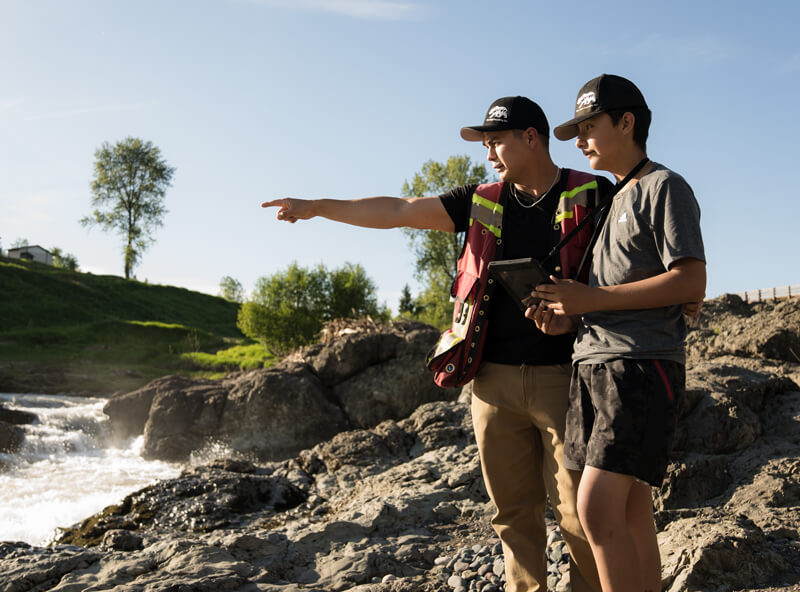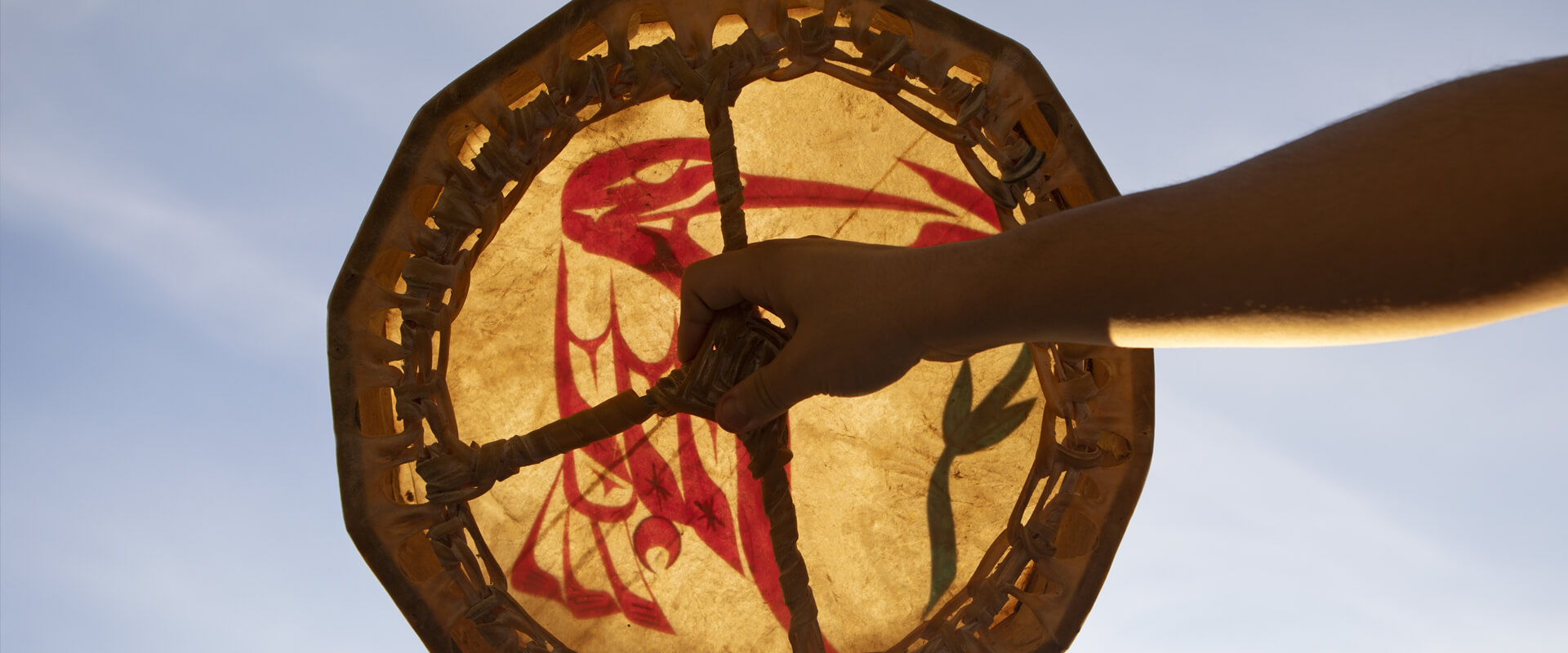
Title and Rights of Indigenous Peoples
Indigenous Peoples exercise and have full enjoyment of their inherent rights, including the rights of First Nations to own, use, develop and control lands and resources within their territories in B.C.
Related stories
Actions at a glance
How far along is this work?
Stage of transformation (Salmon)
When we think of life, it’s cycles of transformation. We think of our relations with salmon. Salmon is the chief of the water and a representation of critical thinking, taking action and overcoming obstacles. Their cycle of birth, journey, and returning to the land remind us of our reciprocal responsibility and that, with our limited time on earth, we must contribute in a meaningful way. Salmon return the earth and feed it so that other beings may thrive.
Lowest level

Started
Mid-level

Planning
High Level

Implementation
Transformed

Completed
How complicated is this work?
Complexity (Rock)
How much work needs to be done? How big is the rock we must carry? We call on the image of the rock, which reminds us of the physicality of our test of strength competitions. The heavy lifting is not just about brute strength but about how we position ourselves and use our whole being to lift.
Lowest level

Some complexity
Mid-level

Moderate complexity
High Level

Notable complexity
Transformed

Complexity resolved
Are there challenges?
Risks (Medicine bundle)
The medicine bundle is a symbol of protection and ceremony. When it comes to risk and challenges, we are reminded of the work that our ancestors undertook to prepare mind, body, and spirit for the things creator would place in front of us. Managing risk is achieved through years of preparation, gaining knowledge, training, ceremony, and mastery.
Lowest level

Some challenges
Mid-level
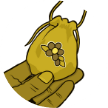
Moderate challenges
High Level

Notable challenges
Transformed
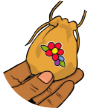
Challenges resolved
How are we working together?
Engagement (Weaving)
Braiding all the necessary pieces together, the land, water, and the people into spaces where deep consultation and co-operation can happen. Each strand is important, each voice is important.
Lowest level
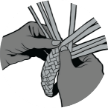
Some engagement
Mid-level

Moderate engagement
High Level

Notable engagement
Transformed

Full engagement
Action
Year
Description
How far along is this work?
How complicated is this work?
Are there challenges?
How are we working together?
-
2.01
1
Establish a Secretariat to guide and assist government to meet its obligation to ensure legislation is consistent with the UN Declaration on the Rights of Indigenous Peoples, and is developed in consultation and cooperation with Indigenous Peoples.Declaration Act Secretariat4143 -
2.02
4
Finalize the Draft Principles that Guide the Province of British Columbia’s Relationship with Indigenous Peoples. Declaration on the Rights of Indigenous Peoples Act Action Plan 2022-2027Ministry of Indigenous Relations and Reconciliation0000 -
2.03
1
Issue guidelines from the Attorney General of B.C. to the Ministry of Attorney General legal counsel regarding the conduct of civil litigation involving the rights of Indigenous Peoples.Ministry of Attorney General4141 -
2.04
1
Negotiate new joint decision-making and consent agreements under section 7 of the Declaration Act that include clear accountabilities, transparency and administrative fairness between the Province and Indigenous governing bodies. Seek all necessary legislative amendments to enable the implementation of any section 7 agreements.Ministry of Indigenous Relations and Reconciliation; Ministry of Water, Land and Resource Stewardship3312 -
2.05
3
Co-develop and employ mechanisms for ensuring the minimum standards of the UN Declaration are applied in the implementation of treaties, agreements under sections 6 and 7 of the Declaration Act and other constructive arrangements with First Nations.Ministry of Indigenous Relations and Reconciliation0000 -
2.06
1
Co-develop strategic-level policies, programs and initiatives to advance collaborative stewardship of the environment, land and resources, that address cumulative effects and respects Indigenous Knowledge. This will be achieved through collaborative stewardship forums, guardian programs, land use planning initiatives, and other innovative and evolving partnerships that support integrated land and resource management.Ministry of Water, Land and Resource Stewardship; Ministry of Indigenous Relations and Reconciliation; Environment and Climate Change Strategy; Ministry of Forests; Ministry of Energy, Mines and Low Carbon Innovation; BC Energy Regulator3313 -
2.07
2
Collaborate with First Nations to develop and implement strategies, plans and initiatives for sustainable water management, and to identify policy or legislative reforms supporting Indigenous water stewardship, including shared decision-making. Co-develop the Watershed Security Strategy with First Nations and initiate implementation of the Strategy at a local watershed scale.Ministry of Water, Land and Resource Stewardship0000 -
2.08
3
Collaborate with Indigenous partners on issues related to conservation and biodiversity in B.C., including the protection of species at risk.Ministry of Water, Land and Resource Stewardship0000 -
2.09
2
Develop new strategies to protect and revitalize wild salmon populations in B.C. with First Nations and the federal government, including the development and implementation of a cohesive B.C. Wild Pacific Salmon Strategy.Ministry of Water, Land and Resource Stewardship0000 -
2.10
2
Reform forest legislation, regulations and policy to reflect a shared strategic vision with First Nations that upholds the rights and objectives of the UN Declaration.Ministry of Forests0000 -
2.11
3
Integrate traditional practices and cultural uses of fire into wildfire prevention and land management practices and support the reintroduction of strategized burning.Ministry of Forests; Ministry of Emergency Management and Climate Readiness0000 -
2.12
1
Collaboratively develop and implement CleanBC and the Climate Preparedness and Adaptation Strategy to support resilient communities and clean economic opportunities for Indigenous Peoples that benefit our shared climate and advance reconciliation.Ministry of Environment and Climate Change Strategy3121 -
2.13
2
Identify and advance reconciliation negotiations on historical road impacts and road accessibility with First Nations on reserve, treaty and title lands, including reporting-out on the completion and implementation of these negotiations collaboratively with First Nations partners.Ministry of Transportation and Infrastructure0000 -
2.14
2
Modernize the Mineral Tenure Act in consultation and cooperation with First Nations and First Nations organizations.Ministry of Energy, Mines and Low Carbon Innovation0000
-
Action
2.01
Year
1
Ministry
Declaration Act Secretariat
Description
Establish a Secretariat to guide and assist government to meet its obligation to ensure legislation is consistent with the UN Declaration on the Rights of Indigenous Peoples, and is developed in consultation and cooperation with Indigenous Peoples.How far along
is this work?4How complicated
is this work?1Are there
challenges?4How are we
working together?3 -
Action
2.02
Year
4
Ministry
Ministry of Indigenous Relations and Reconciliation
Description
Finalize the Draft Principles that Guide the Province of British Columbia’s Relationship with Indigenous Peoples. Declaration on the Rights of Indigenous Peoples Act Action Plan 2022-2027How far along
is this work?0How complicated
is this work?0Are there
challenges?0How are we
working together?0 -
Action
2.03
Year
1
Ministry
Ministry of Attorney General
Description
Issue guidelines from the Attorney General of B.C. to the Ministry of Attorney General legal counsel regarding the conduct of civil litigation involving the rights of Indigenous Peoples.How far along
is this work?4How complicated
is this work?1Are there
challenges?4How are we
working together?1 -
Action
2.04
Year
1
Ministry
Ministry of Indigenous Relations and Reconciliation; Ministry of Water, Land and Resource Stewardship
Description
Negotiate new joint decision-making and consent agreements under section 7 of the Declaration Act that include clear accountabilities, transparency and administrative fairness between the Province and Indigenous governing bodies. Seek all necessary legislative amendments to enable the implementation of any section 7 agreements.How far along
is this work?3How complicated
is this work?3Are there
challenges?1How are we
working together?2 -
Action
2.05
Year
3
Ministry
Ministry of Indigenous Relations and Reconciliation
Description
Co-develop and employ mechanisms for ensuring the minimum standards of the UN Declaration are applied in the implementation of treaties, agreements under sections 6 and 7 of the Declaration Act and other constructive arrangements with First Nations.How far along
is this work?0How complicated
is this work?0Are there
challenges?0How are we
working together?0 -
Action
2.06
Year
1
Ministry
Ministry of Water, Land and Resource Stewardship; Ministry of Indigenous Relations and Reconciliation; Environment and Climate Change Strategy; Ministry of Forests; Ministry of Energy, Mines and Low Carbon Innovation; BC Energy Regulator
Description
Co-develop strategic-level policies, programs and initiatives to advance collaborative stewardship of the environment, land and resources, that address cumulative effects and respects Indigenous Knowledge. This will be achieved through collaborative stewardship forums, guardian programs, land use planning initiatives, and other innovative and evolving partnerships that support integrated land and resource management.How far along
is this work?3How complicated
is this work?3Are there
challenges?1How are we
working together?3 -
Action
2.07
Year
2
Ministry
Ministry of Water, Land and Resource Stewardship
Description
Collaborate with First Nations to develop and implement strategies, plans and initiatives for sustainable water management, and to identify policy or legislative reforms supporting Indigenous water stewardship, including shared decision-making. Co-develop the Watershed Security Strategy with First Nations and initiate implementation of the Strategy at a local watershed scale.How far along
is this work?0How complicated
is this work?0Are there
challenges?0How are we
working together?0 -
Action
2.08
Year
3
Ministry
Ministry of Water, Land and Resource Stewardship
Description
Collaborate with Indigenous partners on issues related to conservation and biodiversity in B.C., including the protection of species at risk.How far along
is this work?0How complicated
is this work?0Are there
challenges?0How are we
working together?0 -
Action
2.09
Year
2
Ministry
Ministry of Water, Land and Resource Stewardship
Description
Develop new strategies to protect and revitalize wild salmon populations in B.C. with First Nations and the federal government, including the development and implementation of a cohesive B.C. Wild Pacific Salmon Strategy.How far along
is this work?0How complicated
is this work?0Are there
challenges?0How are we
working together?0 -
Action
2.10
Year
2
Ministry
Ministry of Forests
Description
Reform forest legislation, regulations and policy to reflect a shared strategic vision with First Nations that upholds the rights and objectives of the UN Declaration.How far along
is this work?0How complicated
is this work?0Are there
challenges?0How are we
working together?0 -
Action
2.11
Year
3
Ministry
Ministry of Forests; Ministry of Emergency Management and Climate Readiness
Description
Integrate traditional practices and cultural uses of fire into wildfire prevention and land management practices and support the reintroduction of strategized burning.How far along
is this work?0How complicated
is this work?0Are there
challenges?0How are we
working together?0 -
Action
2.12
Year
1
Ministry
Ministry of Environment and Climate Change Strategy
Description
Collaboratively develop and implement CleanBC and the Climate Preparedness and Adaptation Strategy to support resilient communities and clean economic opportunities for Indigenous Peoples that benefit our shared climate and advance reconciliation.How far along
is this work?3How complicated
is this work?1Are there
challenges?2How are we
working together?1 -
Action
2.13
Year
2
Ministry
Ministry of Transportation and Infrastructure
Description
Identify and advance reconciliation negotiations on historical road impacts and road accessibility with First Nations on reserve, treaty and title lands, including reporting-out on the completion and implementation of these negotiations collaboratively with First Nations partners.How far along
is this work?0How complicated
is this work?0Are there
challenges?0How are we
working together?0 -
Action
2.14
Year
2
Ministry
Ministry of Energy, Mines and Low Carbon Innovation
Description
Modernize the Mineral Tenure Act in consultation and cooperation with First Nations and First Nations organizations.How far along
is this work?0How complicated
is this work?0Are there
challenges?0How are we
working together?0
Detailed action item reporting
-
2.01
Establish a Secretariat to guide and assist government to meet its obligation to ensure legislation is consistent with the UN Declaration on the Rights of Indigenous Peoples, and is developed in consultation and cooperation with Indigenous Peoples.
Highlights
The Declaration Act Secretariat released The Interim Approach to Implementing the Requirements of Section 3 of the Declaration on the Rights of Indigenous Peoples Act (Interim Approach) in October 2022. The first-of-its-kind Interim Approach provides clarity and transparency around co-development, consultation and co-operation with Indigenous Peoples throughout the provincial legislative process. Examples of legislation that have benefited from the consultation and co-operation guidance from the Secretariat include the Interpretation Act, Forest and Range Practices Act, Freedom of Information and Protection of Privacy Act, Emergency Program Act and the Anti-Racism Data Act. For more details about the work of the Declaration Act Secretariat.
Indicators
- Establishment of the Declaration Act Secretariat: Established April 1, 2022.
- Policies/Reports developed: Interim Approach released October 24, 2022.
How are we working together?
Expert dialogue sessions on section 3 informed the development of the Interim Approach. This guidance is iterative and consultation and co-operation with Indigenous partners will continue.
The Declaration Act Secretariat continues to provide advice and guidance to ministries on alignment with the UN Declaration on the Rights of Indigenous Peoples, consultation and co-operation requirements and engagement with rights and title holders, Indigenous Peoples and organizations.
Are there challenges?
Adequate staffing of the Secretariat to meet the demand for its participation and guidance is a risk, but recruitment is in progress.
The volume of consultation and co-operation engagement requests being sent to Indigenous partners continues to rise and is contributing to consultation fatigue. There is a lack of consistent approaches taken across sectors and ministries to streamline these requests and in some instances previous engagements where ministries would have received feedback on specific priorities are not taken into account.
Ministries are at various points of understanding the requirements they are responsible for under section 3 of the Declaration Act. This can cause some obstacles as it relates to appropriate co-development, consultation and co-operation. For example, when legislative timelines are compressed, it can affect how ministries interpret their responsibilities to consult and co-operate with Indigenous Peoples.
-
2.03
Issue guidelines from the Attorney General of B.C. to the Ministry of Attorney General legal counsel regarding the conduct of civil litigation involving the rights of Indigenous Peoples.
Highlights
The Directives on Civil Litigation involving Indigenous Peoples were published on April 21, 2022. The core objectives of the Directives are to prioritize and promote resolution, innovation and negotiated settlement, and to reduce the potential for litigation involving Indigenous Peoples. When matters do result in litigation, these Directives instruct counsel to engage honourably and to assist the court constructively, expeditiously and effectively.
Legal Services Branch of the Ministry of Attorney General, with the First Nations Leadership Council (FNLC), hosted a professional development session on the Directives in February 2023. The session provided an opportunity to gain context and insight from Indigenous and government leaders, as well as legal practitioners, into the ongoing implementation of the Directives, how they fit within British Columbia’s reconciliation goals and operationalizing the Directives in the practice of litigation.
Indicators
- Policies/Reports developed: Directives issued from the Attorney General of B.C. to the Ministry of Attorney General legal counsel regarding the conduct of civil litigation involving the rights of Indigenous Peoples.
How are we working together?
Meetings with FNLC were held regularly in the development of the Directives.
Are there challenges?
Action complete.
-
2.04
Negotiate new joint decision-making and consent agreements under section 7 of the Declaration Act that include clear accountabilities, transparency and administrative fairness between the Province and Indigenous governing bodies. Seek all necessary legislative amendments to enable the implementation of any section 7 agreements.
Highlights
Tahltan Central Government and the Province entered into the first consent-based decision-making agreement under the Declaration Act in June 2022.
This agreement honours Tahltan’s jurisdiction in land-management decisions in Tahltan Territory, in recognition of Tahltan’s title and rights within its territory. The agreement advances reconciliation as well as provides clarity and predictability for the Eskay Creek Revitalization Project.
The shíshálh Nation and the Province started negotiations on the first joint decision-making agreement to be negotiated under section 7 of the Declaration Act in August 2022.
The agreement, when negotiated, will apply to decisions on dock tenures in the shíshálh swiya (territory/birthplace/world) and builds upon the current model for making shared decisions on dock tenures created in 2018.
The negotiation of section 7 agreements under the Declaration Act demonstrates a structured and intentional approach towards reconciliation. Whether joint or consent-based, these agreements help address the legacy of colonialism by allowing the Province to work together with Indigenous Peoples on decisions that affect them to further reconciliation. Legislative amendments are often required for these agreements to be operationalized.
Indicators
- Number of active negotiations: Two Indigenous governing bodies actively negotiating joint decision-making and consent agreements under section 7 of the Declaration Act.
- Number of legislative amendments: Two legislative amendments made to enable implementation of joint decision-making and consent agreements under section 7 of the Declaration Act during the fiscal year. Legislative amendments were made to the Child, Family and Community Service Act and the Adoption Act.
How are we working together?
Negotiation of section 7 agreements is a collaborative process with Indigenous governing bodies that involves ongoing engagement. In addition, the Province has been working with the First Nations Leadership Council and Alliance of BC Modern Treaty Nations on the approach to the negotiation and implementation of section 7 agreements. Exploratory discussions are underway with other Indigenous governing bodies interested in developing section 7 agreements and are expected to result in additional mandated negotiations.
Are there challenges?
Considerable progress is being made in negotiations and the Province is advancing agreements that share statutory decision-making with Indigenous governing bodies. Although the Declaration Act establishes the space for negotiating section 7 agreements, statutory amendments may be required for these agreements to be implemented. This work takes time, cross-government alignment, and consultation and co-operation with Indigenous Peoples.
-
2.06
Co-develop strategic-level policies, programs and initiatives to advance collaborative stewardship of the environment, land and resources, that address cumulative effects and respects Indigenous Knowledge. This will be achieved through collaborative stewardship forums, guardian programs, land use planning initiatives, and other innovative and evolving partnerships that support integrated land and resource management.
Highlights
There are a wide variety of innovative and meaningful partnerships, programs and initiatives underway that contribute to the advancement of this action:
- Collaborative Indigenous Stewardship Framework (CISF)
- On October 24, 2022, the Province endorsed a long-term commitment to fund regional Collaborative Indigenous Stewardship Forums, including an expanded Cumulative Effects Framework and support for Guardians. This will provide stability and certainty to the work of existing and future forums in delivering resource stewardship through shared decision-making and co-management that brings together Indigenous and non-Indigenous data, knowledge systems and methodologies.
- Collaborative marine planning (i.e., Marine Protected Areas Network and Marine Plan Partnership for the Northern Shelf Bioregion)
- In February 2023, 15 First Nations, the Government of Canada and the Government of B.C. jointly endorsed the Marine Protected Area Network Action Plan (the Action Plan) for the Northern Shelf Bioregion. Rooted in Indigenous knowledge and robust science, the Action Plan is a model of collaborative governance/stewardship and provides a planned approach to the protection of the oceans and their marine wildlife and environments.
- Blueberry River First Nations Implementation Agreement
- Signed on January 18, 2023, between B.C. and Blueberry River First Nations (BRFN), this agreement manages for the past, present and future cumulative impacts of industrial development on treaty rights, better protects those rights and allows for responsible resource development. This agreement includes (but is not limited to) significant and new measures such as establishing a $200 million restoration fund for BRFN to direct projects to heal the land and heal the people, a reduction in commercial timber harvesting activities in important cultural areas to BRFN members and material changes to the regulatory environment for the oil and gas sector.
- Forest Landscape Planning (FLP)
- The Ministry of Forests is undertaking four FLP pilot projects and initiating eight new FLPs throughout the province in collaboration with First Nations and Indigenous organizations. FLPs enable holistic consideration of the way forests are managed in B.C. including how they are managed for cultural values, old growth forest, wildfire and climate change resiliency. These processes represent a true collaboration on establishing how natural resources are managed in B.C. and will be the cornerstone of a new sustainable approach to forestry.
- As well as
- Modernized land use planning
- Great Bear Rainforest Agreement
- Aboriginal Liaison Program
- Guardian Shared Compliance and Enforcement Pilot Project with Kitasoo Xai’xais and Nuxalk First Nations, and
- The Guardians and Stewardship Training Initiative.
Indicators
- Number of engagement participants in programs and events: 120 First Nations participating in collaborative stewardship tables, programs and initiatives.
- Strategic engagement underway: Nine key initiatives that include 20 collaborative stewardship tables, programs and initiatives contributing to implementation.
How are we working together?
For the 2022-2023 reporting year, the focus for consultation and collaboration was for B.C. and First Nations partners to agree on what policies, programs or initiatives currently demonstrate that progress on Action 2.6 is underway. The identified programs and initiatives jointly set priorities for stewardship activities through regionally established forums or partnerships and integrate data and decision-making through a variety of collaborative and co-operative processes. The respect and recognition of Indigenous Knowledge Systems is key in all of these processes. Each of the initiatives identified under 2.6 will contribute to the advancement of this action and represent joint stewardship in action.
Are there challenges?
Risks to fully implementing this action include the following:
- The ability to develop meaningful performance measures in consultation and co-operation with First Nations partners for the whole of 2.6 while respecting the diversity of initiatives, partnerships and governance structures within it
- Engagement/reporting fatigue and capacity constraints and the impact on sustained effort on 2.6 reporting over time, and
- Possible barriers within policy and legislation to advance innovative approaches required to achieve collaborative stewardship in alignment with UN Declaration/Declaration Act.
- Collaborative Indigenous Stewardship Framework (CISF)
-
2.12
Collaboratively develop and implement CleanBC and the Climate Preparedness and Adaptation Strategy to support resilient communities and clean economic opportunities for Indigenous Peoples that benefit our shared climate and advance reconciliation.
Highlights
In collaboration with Coastal First Nations Great Bear Initiative and First Nations Emergency Services Society, the Province is launching the Indigenous Climate Resilience Capacity-building Pilot. The Pilot will identify models for enhancing Indigenous capacity in climate adaptation and resilience and demonstrate the value of this increased capacity of Indigenous communities and organizations to inform potential future investment. It will support First Nations to pursue their climate adaptation planning and implementation priorities and protect First Nations’ title and rights and their holistic health and well-being from the impacts of climate change.
The First Nations Leadership Council, with financial assistance from the Province, will support a Climate Capacity and Needs Assessment for First Nations. This initiative will identify climate capacity best practices, needs, gaps and challenges within First Nations communities to support and strengthen the capacity within and will be available to First Nations to prepare for and respond to climate change. This assessment will also identify barriers to the implementation of self-determined climate change actions and First Nations participation in provincial climate change making decisions and help to develop solutions to those barriers.
The Climate Action Secretariat (CAS) worked with the First Nations Leadership Council – BC Technical Working Group on Climate Change and the Indigenous Climate Adaptation Working Group to collaboratively develop draft indicators for Action 2.12. Measures to evaluate success include the following:
- Appropriate mechanisms or governance structures in place to support collaborative implementation of CleanBC and the Climate Preparedness and Adaptation Strategy. The expected outcome is a formal structure for Indigenous advisory/working groups to engage in dialogue, provide strategic advice and ensure Indigenous perspectives, knowledge and experience of First Nation rights and title holders are included in development and implementation of climate initiatives
- Collaborative prioritization and work planning with Indigenous advisory/working groups, with the outcome of meaningful engagement and collaboration with advisory/working groups on areas of shared priorities pertaining to CleanBC, the Climate Preparedness and Adaptation Strategy and the First Nations Climate Strategy and Action Plan, and
- Indigenous partners, First Nations title and rights holders and treaty rights holders meaningfully engaged, with the outcome of broad engagement with Indigenous Peoples on climate initiatives in addition to collaboration with advisory/working groups.
Indicators
- Strategic engagement underway: Monthly meetings between CAS and two Indigenous advisory groups including the First Nations Leadership Council – BC Technical Working Group on Climate Change and the Indigenous Climate Adaptation Working Group (ICAWG), provide a venue to share information on emerging climate policy and legislative initiatives and advice to CAS staff on consultation and engagement.
- Implementation project underway: ICAWG and CAS worked collaboratively to design and seek project delivery partners for the Indigenous Climate Resilience Capacity-building Pilot Project, which is a project that will continue in 2023/24 to explore ways to support Indigenous climate resilience capacity and skill-building needs.
- Number of engagement participants in programs and events: 95 participants attended the Fall 2022 CleanBC Roadmap to 2030 Indigenous engagement sessions (virtual and in-person); 235 people (representing 113 First Nations and Indigenous organizations) attended the three-day virtual Indigenous Climate Resilience Forum.
How are we working together?
Monthly meetings are held between the Climate Action Secretariat and two Indigenous advisory groups: 1) First Nations Leadership Council – BC Technical Working Group on Climate Change and 2) Indigenous Climate Adaptation Working Group. These working groups were established to provide a technical venue to engage in dialogue, provide strategic advice related to climate change initiatives and ensure that First Nations and Indigenous perspectives and interests are included in development and implementation of CleanBC and the Climate Preparedness and Adaptation Strategy.
Broad Indigenous engagement forums were held on CleanBC Roadmap implementation and attended by 95 First Nations and Indigenous organizations. A virtual Indigenous Climate Resilience Forum was held over three days and attended by 235 people representing 113 First Nations and Indigenous organizations. In addition, individual engagements/consultations were carried out on specific initiatives such as clean energy opportunities, Remote Community Energy Strategy, Forest Carbon Offset Protocol, energy efficiency standards, clean transportation and carbon pricing.
Are there challenges?
There is a clear expectation that new initiatives and legislation align with the Declaration on the Rights of Indigenous Peoples Act (Declaration Act), regardless of when work may have started on them. Recent guidance is helping to ensure this analysis is completed in a consistent and thorough way.
Concerns have been raised regarding the capacity of Indigenous Peoples to meaningfully engage in co-development of policies and legislation associated with B.C.’s climate plans. These issues and approaches to address free, prior and informed consent, will continue to be discussed with the First Nations Leadership Council – BC Technical Working Group on Climate Change in the coming year.
Additional information
A standardized process, which involved participation across the provincial government and engagement with Indigenous partners, guided the development of the Declaration Act Annual Report. This process involved lead ministries identifying when each of the 89 actions in the Declaration Act Action Plan was forecasted to begin substantial implementation (by year), in consideration of logical sequencing of actions that build upon each other, balancing with other commitments, and overall balancing of action plan themes, ministries, sectors, and focus areas.
Once year 1 actions were confirmed, the process involved creating and validating a reporting process for those actions in active implementation; lead Ministries developing and submitting reporting information, often in partnership with Indigenous organizations they work with; and an overall review to ensure accuracy, quality and completeness,.
The reporting information was then used to prepare both the implementation status dashboard and the detailed reporting presented. The calculation of the four icons in the dashboard followed the following method:
How far along is this work?
Determined using standard project schedule stages:
- Planning
- Implementing
- Complete
How complicated is this work?
Calculation: number of identified subtasks for each action + number of Ministries involved in each action + number of years in the planning and implementing stages for each action.
Categorization:
- Some Complexity: score of 4 or less
- Moderate Complexity: score of 5-6
- Notable Complexity: score of 7+
Are there challenges?
Calculation based on “risks” and “obstacles” identified for each action.
How are we working together?
Calculation: yes/no responses to the following questions for each action:
- Partner(s) identified?
- Consultation and co-operation plan or approach is in place or in development with Indigenous partners?
- Partner(s) involved in report development/co-development?
- Input has been gathered/meetings have been held?
Categorization:
- No engagement: score of 0
- Some engagement: score of 1-2
- Moderate engagement: score of 3
- Notable engagement: score of 4
The resulting reporting information was adapted based on input from internal provincial committee processes and from Indigenous partners, including the First Nations Leadership Council, the Alliance of BC Modern Treaty Nations, and Métis Nation British Columbia.
The stories profiled throughout this website were curated based on a consistent set of criteria: they tell a story that involves human impact; there is balance across action plan themes, sectors, geographic region, and lead Ministries; consideration is paid to a distinctions basis; there is substantive progress in advancing the action; and there is an ability to develop content within the project timelines.
There are limitations resulting from the methods used to develop the reporting content, and inherent to undertaking a project of this nature for the first time. These limitations include:
- As this is the first year of the action plan and associated annual report, indicators are mainly process and activity-focused, and as yet not reflective of longer, more meaningful, or more transformational outcomes.
- Standardization of report content, including indicators, was balanced with the work of co-development.
- The project benefitted from learning while doing, meaning that the standardized template and associated dashboard calculations and representation were adapted throughout the process.

